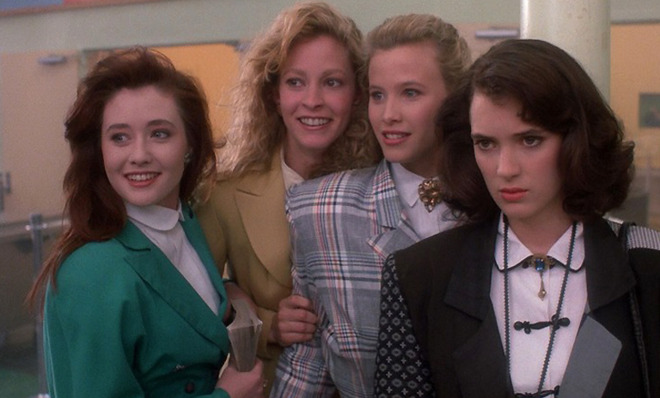How Heathers changed teen movies forever
The pitch-black satire, which debuted 25 years ago this week, set the template for the next generation of teen dramas

When it first hit theaters 25 years ago, audiences weren't quite ready for Heathers. The pitch-black high-school comedy — which sees Winona Ryder and Christian Slater act out a Bonnie and Clyde-style misadventure involving the staged suicides of their high school's cool kids — grossed a pitiful $1 million on an estimated $3 million budget. By any reasonable commercial standard, Heathers was an unmitigated flop.
Fortunately, it didn't stay that way. If you didn't catch Heathers during its brief run at the multiplex, you might be one of the millions who stumbled onto it years later on home video, in syndication, or via the knowing referral of an older friend or sibling. Based entirely on that kind of word-of-mouth, Heathers became one of the biggest sleeper hits of the 1990s, and it achieved a permanent place in the cult canon by the end of the decade.
But Heathers' burgeoning popularity didn't just cement its place in popular culture; Heathers actually began to shape it. Heathers flopped, in part, because it broke from the stiflingly saccharine world that John Hughes ushered into existence with movies like Breakfast Club, Pretty in Pink, and Sixteen Candles.
The Week
Escape your echo chamber. Get the facts behind the news, plus analysis from multiple perspectives.

Sign up for The Week's Free Newsletters
From our morning news briefing to a weekly Good News Newsletter, get the best of The Week delivered directly to your inbox.
From our morning news briefing to a weekly Good News Newsletter, get the best of The Week delivered directly to your inbox.
Hughes laid the foundations of the modern teen film, using crude categories to explicate the highly coded world of cafeteria tribalism and hierarchies. But Heathers was the first movie to show modern teenagers as they really were: Dark, cynical, and often cruel. There were no Molly Ringwald-shaped ugly duckling stories here, and no freeze-frame fist pumps to symbolize the unerring optimism popularized by the Brat Pack.
Those who embraced Heathers saw what felt like one of the first truly honest movies about high school life: a world where the never-ending quest for popularity has actual life-or-death consequences. It's also a world where students battle with bulimia, bullying, and parental indifference. The cool kids have self-esteem issues, the faculty are failing their charges, and the outsider is actually one of the most popular kids in school. Yes, it's deliberately exaggerated — but Heathers' caricatures are still closer to the genuine article than Hughes and Co. ever got. The film's teenaged actors weren't forced to deliver dialogue full of belabored metaphors or unconvincing slang; instead, they said things like, "Dear Diary: My teen angst bullshit now has a body count," capturing the above-it-all smirk that so many teens strive for.
Now, a quarter of a century later, it's clear that Heathers has left its indelible mark on teen drama. The movie's dead-on satire was picked up more than a decade later in Mean Girls, and the seeds of its introspective and intelligent heroine can be recognized in sharply written teen movies like Juno.
But even more than the big screen, Heathers' legacy can be seen in the many teen dramas that have proliferated on television. Beverly Hills, 90210 picked up the trail that was blazed by Heathers, zeroing in on the kind of topical adolescent issues that continue to shape today's teen dramas. The sinister social elite and scathing one-liners have been echoed in modern shows like Glee. And what are frothy teen dramas like Gossip Girl if not a deliberate attempt to give a younger audience the kind of stylish, edgy drama pioneered by Winona Ryder and Christian Slater's dysfunctional duo more than two decades earlier?
A free daily email with the biggest news stories of the day – and the best features from TheWeek.com
Most disconcerting, however, is how prescient Heathers' vision was for the real world. Cafeteria shootings, school bombings, and student suicides; in 1989, Heathers' subject matter was so outlandish it could be safely considered a satirical comedy. By today's standards, a loose summary of the plot could sound like a news report.
As Slater's trenchcoat-wearing bad boy says in the film, "The extreme always seems to make an impression." It's a sentiment that, when it comes to Heathers, still rings true more than 25 years later — even if the bar for "extreme" keeps moving.
Daniel is a freelance writer, an Englishman abroad, and a pop culture junkie. He writes about film, TV, and lifestyle for outlets including MSN, The Guardian, The Times, The Independent, The Evening Standard, and Yahoo.
-
 ‘Let 2026 be a year of reckoning’
‘Let 2026 be a year of reckoning’Instant Opinion Opinion, comment and editorials of the day
-
 Why is Iran facing its biggest protests in years?
Why is Iran facing its biggest protests in years?TODAY’S BIG QUESTION Iranians are taking to the streets as a growing movement of civic unrest threatens a fragile stability
-
 How prediction markets have spread to politics
How prediction markets have spread to politicsThe explainer Everything’s a gamble